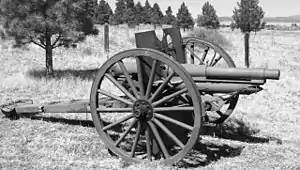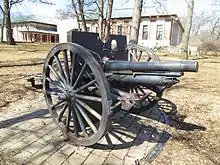3-inch M1902 field gun
The 3-inch field gun M1902 (76.2 mm), a.k.a. M1904 and M1905, was the U.S. Army’s first nickel steel, quick-firing field gun with a recoil mechanism. Like its predecessor the 3.2-inch gun M1897, it was a rifled breechloader.
| 3-inch M1902 Field Gun | |
|---|---|
 M1905 model | |
| Type | Light field gun |
| Place of origin | United States |
| Service history | |
| In service | 1902–1920s |
| Used by | US Army |
| Wars | World War I |
| Production history | |
| Designer | Watervliet Arsenal |
| Designed | 1902 |
| Produced | 1902–1917 |
| No. built |
|
| Variants | M1902, M1904, M1905 |
| Specifications | |
| Mass | gun & breech : 835 lb (379 kg) (1902 & 1904) 788 lb (357 kg) (1905); 2,520 lb (1,140 kg) gun & carriage total. |
| Length | 180 in (460 cm) From trail to muzzle |
| Barrel length | 28 calibers, 7 feet (2.1 m) (bore) |
| Width | 76 in (190 cm) |
| Height | 63 in (160 cm) |
| Crew | 5 |
| Shell | Fixed QF 76.2 x 273mm R[1] |
| Shell weight | 15 lb (6.8 kg) |
| Calibre | 3-inch (76.2 mm) |
| Breech | Interrupted screw, De Bange type |
| Recoil | hydro-spring, 45 inches (1.14 m) |
| Carriage | wheeled |
| Elevation | -5° to +15° |
| Rate of fire | 15 rounds per minute |
| Muzzle velocity | 1,700 ft/s (520 m/s) |
| Effective firing range | 6,000 yd (5,500 m) at 15° elevation |
| Maximum firing range | 8,500 yd (7,800 m) approx. |
| Feed system | hand |
Design
The features of rifling, breech loading with fixed ammunition, and a hydraulic-spring system to absorb the gun's recoil and quickly return it to the firing position combined to improve the range, accuracy, and rate of fire of the gun compared with previous weapons, allowing it to be used more effectively in operations with infantry. These new capabilities allowed the gun to provide accurate indirect fire on targets not in a direct line of sight, which provided crucial firepower for infantry attacks. It was also one of the first US artillery guns with an armored shield to protect the crew from small arms fire. The gun fired 3 inches (76 mm) steel, shrapnel, or explosive shells that weighed 15 pounds (6.8 kg).[2] The use of nickel steel construction meant that the M1902 could fire a heavier shell at a higher muzzle velocity and greater accuracy (due to tighter rifling) than any other field gun of American origin to that point.[3] It had a muzzle velocity of 1,700 ft/s (520 m/s) with an effective range of 6,500 yards (5,900 m), and a maximum range of 8,500 yards (7,800 m). The maximum rate of fire was 15 rounds per minute.
Service history
This weapon replaced the 3.2-inch gun M1897 in most combat units, but both weapons remained in service until after World War I. General John J. Pershing brought several of the guns with him during the Mexican Punitive Expedition in 1916–17, but they were not fired in combat.[3]
The M1902/5 was in service from 1905 through 1919. During World War I, the Army primarily used the French 75 mm gun instead of the M1902s, which were mostly kept in the United States for training. Although this weapon appears in World War I-era tables of organization and equipment,[4] very few of the M1902s were used in combat in Europe. They were gradually phased out of active service in the 1920s.
Surviving examples



- One M1904 3-inch Field Gun, Southern Utah University Army ROTC, Cedar City, Utah. Still in working order and being fired (blank rounds) during football games.
- Cantigny Park, in Wheaton, Illinois.[2]
- Westminster, Massachusetts[5]
- One on the courthouse grounds, New London (Ralls County), MO.[6]
- U.S. Army Ordnance Training and Heritage Center, Fort Lee, Virginia.[7]
- Fort Sam Houston[8]
- One gun at 45th Division Museum, Oklahoma City, OK[9][10]
- One at Clemson University
- One complete unit at Fort Sill museum.
- One model 1902, number 56, manufactured in 1905, by the Rock Island Arsenal in front of the American Legion hall, Eustis, Florida.
- Two at Texas A&M University. Operated by the Corps of Cadets, Parsons' Mounted Cavalry Half Section (the most famous is named The Spirit of '02. The second is on loan to Tarleton State University).
- One 3-inch M1902 gun at the Texas Military Forces Museum, Austin, Texas.
- One at Minnesota State Academy for the Deaf, Faribault, MN
- Three at Valley Forge Military Academy and College in Wayne, PA
- One at Veterans of Foreign Wars Post no. 33, Greensburg, PA
- One 3-inch M1902 field gun in Mission County Park, San Antonio, Texas. The gun is missing its wheels.
- One in Columbus, New Mexico
- One in Presidio of Monterey, CA
- One in Annandale, VA
- One at Liberty Park in Hudson, Massachusetts
- One in New Bedford, Massachusetts
- One in Cullman, Alabama on route 278 and High Way 65. It is missing breech block. Wheels are in need of repair. Model 1905.
- One at Camp Edwards, Massachusetts
- One at the Newport Artillery Company Armory, Newport, RI
- One complete unit at High Street Cemetery, Danvers, Massachusetts
- Two at Lakeview Park in the City of Lorain near Cleveland, Ohio
- A refurbished 1902 American field gun is on display in the city of Hopewell, VA
- A recently restored 3-inch M1904 field gun is in the possession of 3-7 Field Artillery at Schofield Barracks, HI
- A restored 3-inch M1902 field gun is on display at the U. S. Army Museum of Hawaii at Fort DeRussy in Honolulu, HI
- Costa Mesa, California
- One M1905 on the grounds of the Rush County Courthouse, Rushville, Indiana
- Two at the Washington National Guard Museum, Camp Murray, Washington
- One M1905 on the grounds of VFW Post 5700 in Hightstown, NJ
- One M1902 on the parade grounds of Ft. Meade, South Dakota
- One M1902 at the Illinois State Military Museum in Springfield, IL
- One M1902 at the West End World War I Memorial Park in Amsterdam, NY - serial number 155
- One 3-inch gun at the American Legion post, Patchogue, New York
- Two M1902 guns sit outside Christian Brothers Academy in Albany, NY
- One M1905 at the VFW Post 3911. Key West, FL
- One M1905, missing the wheels, is located in Brighton, IL
- One, model not identifiable, at the side of the American Legion post in Ottawa, IL
- Two M1905 at Fort Niagara State Park, NY
See also
Weapons of comparable role, performance and era
- 76 mm divisional gun M1902 Russian equivalent
- 7.7 cm FK 96 n.A. German equivalent
- Ordnance BLC 15 pounder and Ordnance QF 15 pounder British equivalent
Notes
- "77-77 MM CALIBRE CARTRIDGES". www.quarryhs.co.uk. Retrieved 2017-09-05.
- M1902 3 Inch Field Gun, 1st Division Museum, Cantigny
- Williford, pp. 22-25
- Rinaldi, p. 204
- 3-inch gun, Westminster, MA at Waymarking.com
- 3-inch gun, New London, MO at Waymarking.com
- Photos of weapon formerly at Aberdeen Proving Ground, MD
- M1905 field gun at Historical Marker Database
- 3-inch gun, Oklahoma City, OK at Waymarking.com
- "45th Division Museum". Archived from the original on 2007-10-27. Retrieved 2019-09-11.
References
- "Handbook of artillery : including mobile, anti-aircraft and trench matériel (1920)"
- Handbook of the 3-inch Gun Matériel, model of 1902 War Department Ordnance Form No.1659 revised June 5, 1917
- "Instructions for Mounting, Using and Caring For the 3-Inch (15-pounder) Gun" revised 1913 Ordnance Form No. 1766
- Rinaldi, Richard A. (2004). The U. S. Army in World War I: Orders of Battle. General Data LLC. ISBN 0-9720296-4-8.
- Williford, Glen M. (2016). American Breechloading Mobile Artillery, 1875-1953. Atglen, Pennsylvania: Schiffer Publishing. ISBN 978-0-7643-5049-8.
External links
| Wikimedia Commons has media related to 3 inch Gun Model 1902-1904-1905. |
- Description of 3-inch (15 pounder) gun, model of 1903, and its breech mechanism. Ordnance Department USA 1912 revised 1917 at State Library of Victoria
- Lieut.-Col. E.L. Gruber, "Notes on the 3 inch gun materiel and field artillery equipment. Compiled for the Reserve Officers' Training Corps of Yale University". 1917.